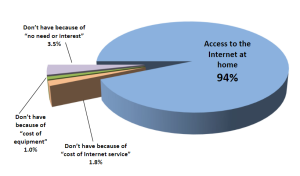Technology adoption and affordability in Canada
A new report looks at technology adoption and affordability through analysis of recent Statistics Canada data. I promised a look at this report in my recent post on rural broadband solutions.
Communic@tions Management Inc. (CMI) published “Technology adoption, use, and affordability in Canada” [pdf, 1.1 MB], documenting key indicators for how Canadians relate to the internet and smartphones. Through the years, CMI has developed an expertise in analyzing and interpreting Statistics Canada publications, in addition to developing custom tabulations and correlations of the raw Statistics Canada data.
CMI estimates that in 2023, 95% of Canadian households had home internet connections, and 90% of households had smartphones. An additional 5% of households had mobile devices that were not smartphones, for total mobile adoption rate of 95%.
CMI notes that in 2021, more than half of Canadian households now rely exclusively on cell phones for their phone service – a notable milestone.
CMI took a look at spending by income quintile (similar to what I have done in the past) and added in a comparison to spending by income quintile in the US. “Across most income groups, Canadian households spend less on cellular service than do Americans.”
While we know that the mobile phone has become a substitute for wireline phone service, CMI says “it is not unreasonable to state that the smartphone has substitution effects for landlines, photographic services, newspapers, and magazines and periodicals.” Looking at other data from the 2021 Survey on Household Spending, CMI found the following changes in average household spending on each of these items from 2010 to 2021:
- Landline telephone services -56.4%
- Photographic services -42.8%
- Newspapers -27.3%
- Magazines and periodicals -50.0%
During that period, the number and percentage of households with cell phones was increasing – from 78.1% of households in 2010 to 93.9% in 2021. And, within those totals, an increasing number of devices were smartphones.
CMI also notes that the Survey of Household Spending estimated there were 13,297,000 households, of which 10,378,000 had cell phones. Using Statistics Canada data, CMI estimated there were at least 17,772,000 cell phones in use at that time. By 2021, 14,197,000 out of Canada’s 15,123,000 households had at least 26,759,000 mobile phones. “In other words, from 2010 to 2021, the number of total households went up 13.7 per cent; the number of households with cell phones went up 36.8 per cent; and the number of cell phones in those households went up 50.6 per cent.”
Using data from custom tabulations of Statistics Canada’s General Social Survey, CMI found that smartphone owners were almost twice as likely to read news online daily, compared to those that do not own smartphones; and smartphone owners were less than half as likely to read a print copy of a newspaper daily, compared to those that do not own smartphones.
 To examine affordability, CMI turned to Statistics Canada’s 2022 Canadian Internet Use Survey (CIUS). As seen in the figure, “home Internet is nearly ubiquitous for Canadians, and “no need or interest” is the most important reason for non-adoption.”
To examine affordability, CMI turned to Statistics Canada’s 2022 Canadian Internet Use Survey (CIUS). As seen in the figure, “home Internet is nearly ubiquitous for Canadians, and “no need or interest” is the most important reason for non-adoption.”
Adoption varies by age, ranging from 99.3% in the age group 15-24; 98.8% for ages 25-34; 98.0% for ages 35-44; 96.7% for ages 45-54; 93.1% for ages 55-64 and 83.7% for those 65 and older. In each segment, “No need or no interest” was the dominant reason for non-adoption, beating out “the cost of equipment” and “the cost of the service”. CMI stated “In other words, there is much more likely a demographic link based on age than an affordability link based on income.” Similar results were found for smartphone adoption.
There are clear policy implications that arise from CMI’s work. As CMI says,
Thus, one might say that the adoption of Internet and smartphone technology in Canada is nearly ubiquitous, with age and attitudes a much greater factor than affordability when influencing non-adoption.
To the extent it is a goal of public policy to maximize adoption – and use – of these technologies, targeted solutions, including measures to improve digital literacy and skills, especially among older adults, would appear to be more logical and efficient than broader, more disruptive, industry structural changes.
It is worth emphasizing that sentence: “Targeted solutions, including measures to improve digital literacy and skills, especially among older adults, would appear to be more logical and efficient than broader, more disruptive, industry structural changes.” This resonates with themes you have seen before on these pages.
The distillation of data in the report is worth keeping in mind as we turn our minds toward 2025 plans and objectives. Targeted solutions will be an approach for policy strategists to keep in mind when developing platforms for the 2025 election.
The full report is a worthwhile read.
